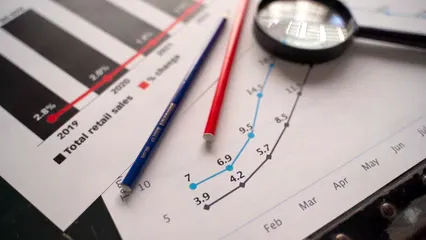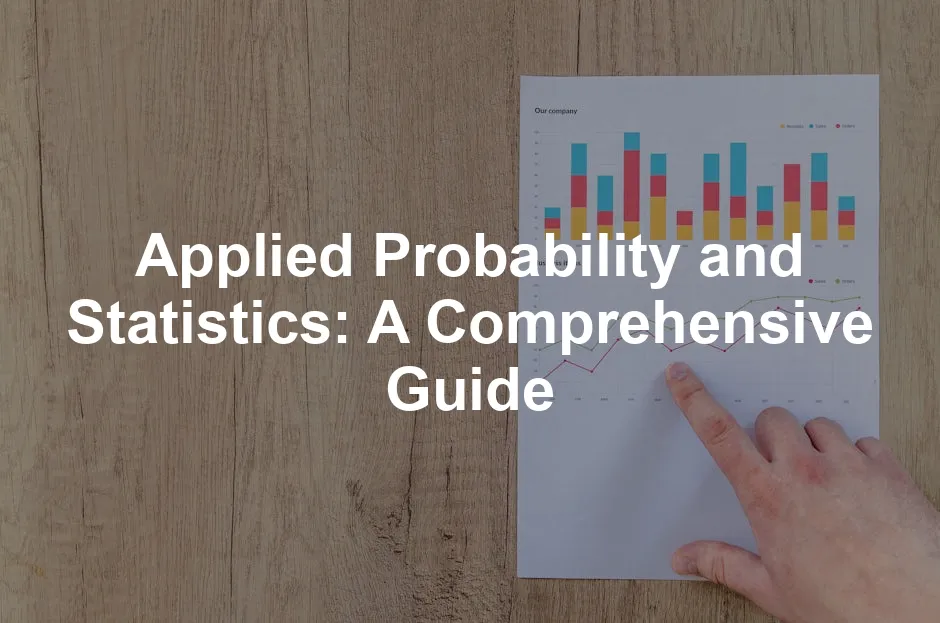Introduction
Applied probability and statistics are the dynamic duo of the mathematical world. They tackle real-life problems across countless fields, from engineering to economics. Ever wondered how engineers predict the durability of a bridge? Or how economists forecast market trends? That’s applied probability and statistics in action!
In simple terms, applied probability involves using probability theory to solve practical problems. It’s like taking the theoretical math you learned in school and giving it a real-world twist. Statistics, on the other hand, is about collecting, analyzing, and interpreting data. Together, they form a foundation for decision-making in uncertain environments.
This article aims to provide a comprehensive understanding of applied probability and statistics. We’ll break down essential principles, examine various applications, and highlight their relevance in everyday scenarios. By the end, you’ll see just how vital these concepts are in our data-driven world.
Whether you’re a student gearing up for exams, a professional looking to enhance your skills, or just someone curious about the numbers behind daily life, this guide is tailored for you. Let’s embark on this enlightening journey through the exciting landscape of applied probability and statistics!

To kickstart your journey, consider grabbing a copy of “The Art of Statistics: Learning from Data” by David Spiegelhalter. It’s a fantastic primer that makes the world of statistics accessible and fun!
Understanding Applied Probability
What is Applied Probability?
Applied probability is the practical application of probability theory to real-world problems. Unlike pure probability, which focuses on theoretical aspects, applied probability deals with real-life scenarios. Imagine you’re at a carnival, trying to win a giant stuffed bear. Understanding the odds of winning is applied probability at work!
This branch of mathematics is crucial for solving various practical problems. It helps professionals in fields like engineering, finance, and healthcare make informed decisions. For instance, engineers use it to assess risks in construction projects, while financial analysts apply it to predict stock market trends.
Applied probability transforms abstract concepts into actionable insights. It provides a structured way to tackle uncertainty, making it a valuable tool for anyone dealing with risk and variability.

If you’re interested in a deeper dive into probability concepts, check out “Naked Statistics: Stripping the Dread from the Data” by Charles Wheelan. It’s a witty and engaging read that demystifies statistical concepts!
Historical Background
The journey of applied probability is as fascinating as the subject itself. It began gaining traction in the late 1950s, when the term was popularized at a symposium of the American Mathematical Society. Notable figures like Maurice Bartlett played a significant role in shaping this discipline. His work laid the groundwork for a deeper understanding of probability theory in practical contexts.
Over the years, several milestones marked the evolution of applied probability. The establishment of dedicated journals, such as the Journal of Applied Probability, in 1964 facilitated the dissemination of research and ideas. These platforms provided a space for scholars to present their findings, fostering collaboration and innovation in the field.
Today, applied probability is a vibrant area of study, intersecting with various scientific domains. Its principles are employed in everything from telecommunications to population genetics. As researchers continue to explore new applications, the significance of applied probability in addressing real-world challenges only grows.
Key Concepts in Applied Probability
Events and Probability Spaces
Let’s kick things off with the basics! In applied probability, we talk about events and probability spaces. An event is a specific outcome or a set of outcomes from a random experiment. Imagine you’re tossing a coin. The event could be “landing on heads.” Simple, right?
Now, what’s a probability space? It’s the mathematical framework that combines everything we need to analyze probabilities. It consists of three components:
1. Sample Space (S): The set of all possible outcomes. For our coin toss, S = {Heads, Tails}.
2. Events (E): A subset of the sample space. For example, E = {Heads} is an event.
3. Probability Measure (P): A function that assigns probabilities to events. It tells us how likely an event is to occur. For a fair coin, P(Heads) = 0.5.
Understanding these concepts is crucial. They lay the foundation for everything else in applied probability. You can’t build a house without a solid base, right?

Random Variables
Now let’s spice things up with random variables! A random variable is a numerical outcome of a random process. Think of it as a function that maps events from the sample space to real numbers.
There are two main types:
1. Discrete Random Variables: These take on a countable number of values. For example, the number of heads when flipping three coins could be 0, 1, 2, or 3.
2. Continuous Random Variables: These can take on an infinite number of values within a range. Imagine measuring the height of students in a class. It can be any value within a specific range.
Why are random variables significant? They help us model real-world phenomena. By using them, we can perform calculations, make predictions, and analyze data trends. It’s like having a crystal ball—only more mathematical and less mystical!
Applications of Applied Probability
Applied probability isn’t just theoretical—it’s everywhere! It plays a vital role across various fields, making it a powerful tool for decision-making.
In engineering, applied probability is crucial for risk assessment. Engineers evaluate potential failures in structures. For instance, when designing a bridge, they calculate the probability of extreme weather conditions affecting its safety. This helps them build stronger, safer structures.
Moving to the finance sector, applied probability shines in areas like stock option pricing. Financial analysts use probabilistic models to determine the fair value of options, helping investors make informed choices. By assessing market volatility and historical data, they can estimate the likelihood of certain price movements.
In the natural sciences, researchers apply probability to model population dynamics, disease spread, and more. For example, epidemiologists use it to predict the spread of infectious diseases. By analyzing patterns and probabilities, they can implement effective public health strategies.

For professionals looking to delve deeper into these concepts, I highly recommend “How to Measure Anything: Finding the Value of ‘Intangibles’ in Business” by Douglas W. Hubbard. It’s a treasure trove of practical applications of probability!
In summary, applied probability is a game-changer in many fields. It empowers professionals to tackle uncertainty, make informed decisions, and innovate solutions. Whether it’s assessing risks in engineering or pricing options in finance, its impact is profound and far-reaching!
Statistical Inference
Statistical inference is a key concept that allows us to draw conclusions about a population based on sampled data. Imagine you’re at a party, and you taste-test a few appetizers. You might conclude that the whole spread is delicious based on just a few bites. That’s statistical inference in action!
At the heart of statistical inference are three main concepts: hypothesis testing, confidence intervals, and p-values.
Hypothesis testing is like a courtroom drama. You start with a null hypothesis—think of it as the innocent until proven guilty stance. You gather data to see if there’s enough evidence to reject this hypothesis in favor of an alternative one.
Next, we have confidence intervals. These handy tools give us a range of values that likely contain the true population parameter. It’s like saying you’re 95% sure that the average height of all the party-goers falls between 5’5″ and 5’11”. Pretty reassuring, right?
Now, let’s talk about p-values. This little number tells us how likely we would see our data if the null hypothesis were true. A low p-value (typically below 0.05) suggests that we should reject the null hypothesis. It’s the statistical equivalent of finding a smoking gun!
These concepts are widely applied in real-world scenarios. For instance, in clinical trials, researchers use hypothesis testing to determine if a new drug is effective compared to a placebo. They establish confidence intervals to express the uncertainty of the effect size. P-values help decide whether the results are statistically significant. For a deeper dive into hypothesis testing, check out our statistics hypothesis testing cheat sheet.

Understanding hypothesis testing is crucial for statistical inference. Learn more about hypothesis testing.
So next time you bite into a tasty appetizer, just remember: there’s a lot more math behind that than you might think!
Applications of Statistics
Statistics is the backbone of a multitude of fields, offering insights that drive decisions and innovations. Let’s explore some key areas where statistics play a pivotal role.
Scientific research relies heavily on statistics. Researchers use statistical methods to analyze data from experiments, helping them validate their hypotheses. For example, a physicist studying particle collision data utilizes statistical techniques to identify significant patterns and anomalies.
In manufacturing, quality control is paramount. Statistics helps companies monitor production processes and ensure product quality. A case study of a car manufacturing plant illustrates this perfectly. By applying statistical process control (SPC), the plant can detect variations in the production line, allowing them to address issues before they escalate into costly defects. For insights into statistical methods for finance, check out our statistical methods for finance professionals 2024.

Statistical methods are essential across various industries. Explore statistical methods for finance professionals.
Let’s not forget about public health studies. Statisticians analyze data from surveys and clinical studies to understand health trends. During the COVID-19 pandemic, for example, statistical models were crucial in predicting the spread of the virus and informing public health policies.
One compelling case study involves the application of statistics in vaccine trials. Researchers analyze the effectiveness of vaccines through randomized controlled trials, employing statistical methods to determine how well the vaccine protects against infection. This critical data guides regulatory decisions and public health recommendations.
From research labs to manufacturing floors and public health offices, statistics acts as the guiding light, illuminating paths to better decisions and outcomes. Whether it’s ensuring the safety of a new drug or maintaining quality in production, statistical methods are indispensable.
Regression Analysis
Regression analysis is like having a magic lens to understand relationships between variables. Simple linear regression looks at the relationship between two variables. Think of it as a straight line that best fits data points on a graph. It’s like finding the perfect pizza topping combo based on previous party feedback!
Now, multiple linear regression takes it a step further. It considers multiple variables to predict outcomes. Imagine trying to forecast your next party’s success. You’d consider the guest list, the theme, the snacks, and maybe even the playlist! This approach helps identify which factors influence your event’s success the most.
These techniques are essential for various practical applications. For instance, businesses utilize regression to forecast sales. By analyzing past sales data, they can predict future trends. This information drives inventory decisions and marketing strategies.
In the financial sector, regression analysis helps in risk management. Financial analysts assess how different economic factors impact stock prices. This knowledge is crucial for making informed investment decisions.

In summary, regression analysis is a powerful tool. It not only helps us understand relationships but also enables accurate forecasting in various fields. If you want to dive deeper into regression analysis, I suggest “Statistics for Dummies” by Deborah J. Rumsey. It breaks down complex concepts into digestible bites!
Recent Developments in Applied Probability and Statistics
Current Trends and Innovations
Applied probability and statistics are evolving rapidly. Recent advancements, particularly in machine learning and big data analytics, are revolutionizing this field. Machine learning combines statistics and computer science to analyze vast data sets. This technology enables us to uncover patterns that traditional methods might miss.
Big data analytics is another game-changer. It allows researchers to process massive amounts of data quickly. This capability is crucial in fields like healthcare, where patient data can reveal trends in treatment effectiveness.
Moreover, technology has made statistical tools more accessible. Cloud-based platforms offer powerful analytics capabilities, allowing even small businesses to harness data for decision-making. This democratization of data analysis empowers organizations to make informed choices based on statistical evidence.

Challenges and Future Directions
Despite its advancements, applied probability and statistics face challenges. Data privacy is a significant concern. As organizations collect more data, ensuring its security becomes paramount. Striking a balance between data utility and privacy rights is crucial.
Ethical considerations also come into play. The use of statistical models can lead to biased outcomes if not managed carefully. Researchers must be vigilant in ensuring fairness in their methodologies.
Looking ahead, several areas show promise for future research. Developing more robust statistical methods to handle complex data structures is vital. Additionally, as machine learning continues to grow, integrating it with traditional statistical methods could yield powerful insights.
Overall, the future of applied probability and statistics is bright. As technology advances, the potential for innovative solutions to real-world problems increases. The importance of ethical considerations and data privacy will shape the direction of this dynamic field.
Conclusion
In conclusion, applied probability and statistics are cornerstones of modern science. They provide the tools to make sense of uncertainty and variability. From engineering and finance to healthcare and social sciences, these disciplines play vital roles.
We explored regression analysis as a means to understand relationships between variables and forecast future outcomes. Current trends, like machine learning and big data analytics, are reshaping the landscape of applied probability and statistics. However, challenges such as data privacy and ethical considerations remain.
As we look forward, the integration of traditional statistical methods with advanced technologies holds great promise. The future of applied probability and statistics is not only about dealing with data but also about making informed decisions that impact our lives positively.
Let’s embrace this journey of numbers, probabilities, and statistics. After all, in a world driven by data, understanding these concepts is more crucial than ever!
FAQs
What is the difference between applied and theoretical statistics?
Applied statistics focuses on real-world data analysis and problem-solving. It’s like the superhero of statistics, swooping in to tackle practical issues. For example, when a researcher analyzes survey data to predict consumer behavior, they’re using applied statistics. Theoretical statistics, on the other hand, dives into the mathematical foundations. It’s more about the ‘why’ than the ‘how.’ Think of it as the philosopher of statistics, pondering the underlying principles. An example would be deriving new statistical methods or proving theorems related to sampling distributions. In short, applied statistics is hands-on, while theoretical statistics is more about the concepts behind the scenes!
How can I learn applied probability and statistics?
Learning applied probability and statistics can be a fun ride! Here are some great resources to get you started: 1. **Textbooks**: Grab a copy of *Applied Probability and Statistics* by Mario Lefebvre. This book is tailored for engineering and science students. It’s packed with real-life exercises to help you grasp concepts. 2. **Online Courses**: Platforms like Coursera, edX, and Khan Academy offer excellent courses. These often include lectures, quizzes, and projects to reinforce your learning. 3. **Academic Programs**: Consider enrolling in a degree program that includes applied statistics. Many universities offer bachelor’s and master’s degrees in statistics or data science. 4. **YouTube Tutorials**: Don’t underestimate the power of YouTube! Channels dedicated to math and statistics often provide clear explanations and visual aids. 5. **Practice Problems**: Websites like Brilliant and Stat Trek provide interactive exercises to sharpen your skills. With these resources, you’ll be well on your way to mastering applied probability and statistics!
What are some common applications of applied statistics?
Applied statistics is everywhere, making a difference in various fields! Here are some common applications: – **Healthcare**: Analyzing clinical trial data to evaluate new treatments. It helps determine the effectiveness and safety of medications. – **Finance**: Risk assessment and stock market analysis. Financial analysts rely on statistical models to make informed investment decisions. – **Engineering**: Quality control processes ensure products meet safety standards. Engineers use statistics to analyze failure rates and design safer structures. – **Social Sciences**: Survey analysis helps researchers understand societal trends, such as voting behavior or public opinion. – **Marketing**: Businesses use statistical analysis to determine customer preferences and optimize marketing strategies. In short, applied statistics is a vital tool in decision-making across countless industries!
How is machine learning related to applied probability and statistics?
Machine learning and applied probability/statistics are like peanut butter and jelly! They complement each other beautifully. Machine learning leverages statistical methods to make predictions and identify patterns in data. It uses algorithms that require a solid understanding of probability. For instance, probability distributions help machine learning models understand the uncertainty in predictions. Moreover, concepts like regression analysis are foundational in both fields. In machine learning, regression models help predict outcomes based on input features. In essence, applied probability and statistics provide the theoretical backbone, while machine learning applies these ideas to solve practical problems. Together, they drive innovation in data science and artificial intelligence!
What are some good textbooks on applied probability and statistics?
Looking for some solid textbooks? Here are a few recommendations: 1. **”Applied Probability and Statistics” by Mario Lefebvre**: This book is perfect for engineering and science students. It covers essential topics with practical examples and exercises. 2. **”Probability and Statistics for Engineering and Science” by Jay L. Devore**: This classic textbook combines theory and applications, making it a great resource for students. 3. **”Introduction to Probability and Statistics” by William Mendenhall, Robert Beaver, and Barbara Beaver**: This book provides a comprehensive overview of the subject, with numerous examples and exercises. 4. **”Statistical Inference” by George Casella and Roger L. Berger**: While more theoretical, this book offers deep insights into statistical methods that are crucial for advanced study. 5. **”The Elements of Statistical Learning” by Trevor Hastie, Robert Tibshirani, and Jerome Friedman**: This book is ideal for those interested in machine learning applications of statistics. These textbooks are fantastic resources to help you navigate the fascinating world of applied probability and statistics!
Please let us know what you think about our content by leaving a comment down below!
Thank you for reading till here 🙂
All images from Pexels




